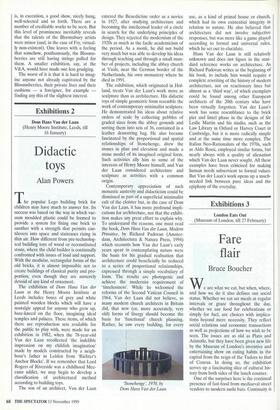Exhibitions 3
London Eats Out (Museum of London, till 27 February)
Fare flair
Bruce Boucher
We are what we eat, but when, where, and how we do it also defines our social status. Whether we eat set meals at regular intervals or graze throughout the day, whether we use food for celebrations or simply for fuel, are choices with implica- tions beyond mere necessity. They reflect social relations and economic transactions as well as projections of how we wish to be seen. The issues are as old as Plato and Aristotle, but they have been given new life by the Museum of London's inventive and entertaining show on eating habits in the capital from the reign of the Tudors to that of Conran. In doing so, the exhibition serves up a fascinating slice of cultural his- tory from both sides of the lunch counter.
One of the surprises here is the continual presence of fast-food from mediaeval street vendors to modern sushi bars. Continuity is evoked by a theme-line running throughout the exhibition with telling juxtapositions: prints of 17th-century gingerbread-sellers are wedged between a currant-bun baked for the Coronation of George IV and a contemporary plastic sandwich box; in one corner an 18th-century coffee house is recreated and, in another, a booth from that beacon of 1950s functionalism, the Time-Life Building cafeteria. Here and there paintings add another dimension by illustrating kitchen still-lifes or, most mem- orably, a Tudor fête at Bermondsey by Hoefnagel, with its glimpse of a kitchen rotisserie and starched table setting for the gentry.
There is, of course, a serious sub-text to all this: food involves money and social hierarchy at almost every turn. The 17th- century coffee houses were revolutionary for not serving alcohol, and the sobriety and stimulus of coffee provided the ideal conditions for financial transactions and networking. Food still has patriotic over- tones as the section on roast beef exempli- fies. A hearty slab of beef, the fabled 'Sir Loin', was seen by 18th-century Londoners as part of their birthright and a symbol of English prosperity as opposed to the mea- gre fare of Continentals. This aspect is rep- resented by a series of topical engravings on the importing of inferior foreign fare as well as by a silver tankard from the Beef- steak Club with the motto 'Beef and Liber- ty'. As elsewhere in this exhibition, the topical overtones scarcely need stressing.
The 19th century saw the introduction of dining out,as we would recognise it today. The concept and the word 'restaurant' were introduced, and hotels were re- invented as places of public refreshment for both sexes. These transformations were fuelled by the tremendous growth in Lon- don's population and the impact of the rail- ways on patterns of work and dining. Most of the railway lines had station hotels with several public rooms for dining, often with one reserved for ladies only. These restau- rants were the direct descendants of the old coffee houses and coffee rooms of gen- tlemen's clubs, but their scale and decora- tion were far more opulent, appealing to a new type of clientele. The Midland Grand at St Pancras station contained a coffee room 100 feet long, with painted ironwork, a coffered ceiling and a decorative frieze. Plates and utensils also underwent a trans- formation, no longer wooden or pewter but porcelain accompanied by crystal and silver plate. At the other end of the scale, the Victorians also had to cope with increasing numbers of urban poor through soup kitchens which gave hundreds their only experience of warm food.
The 20th century has largely built upon the trends established 100 years ago, but few would have predicted then the current renaissance of London as 'restaurant capi- tal of the world'. Affluence and a greater variety of eating places have contributed to this, not to mention the decline in the num- ber of domestic servants and the rise of chains like the Lyons Corner Houses. But, above all, migration played a notable part with the Franco-Italo-Swiss monopoly of the earlier part of the century first giving way to Indian and Chinese and latterly to our world-wide dining out. There is a good section on ethnic food here as well as an array of fast-food wrappers and table set- tings from some of the best contemporary establishments.
London Eats Out caters for all types and is presented with all the flair one now expects in a smart new restaurant. For any- one under 20, it will come as a revelation that hamburgers and curries have not always been part of the national diet; for the rest of us, there is an ample dose of nostalgia as well as the occasional shock of recognition. In short, there is plenty of food and food for thought on offer.
Wax portrait group of Dr Johnson in The Turk's Head tavern, c. 1790



























































































 Previous page
Previous page